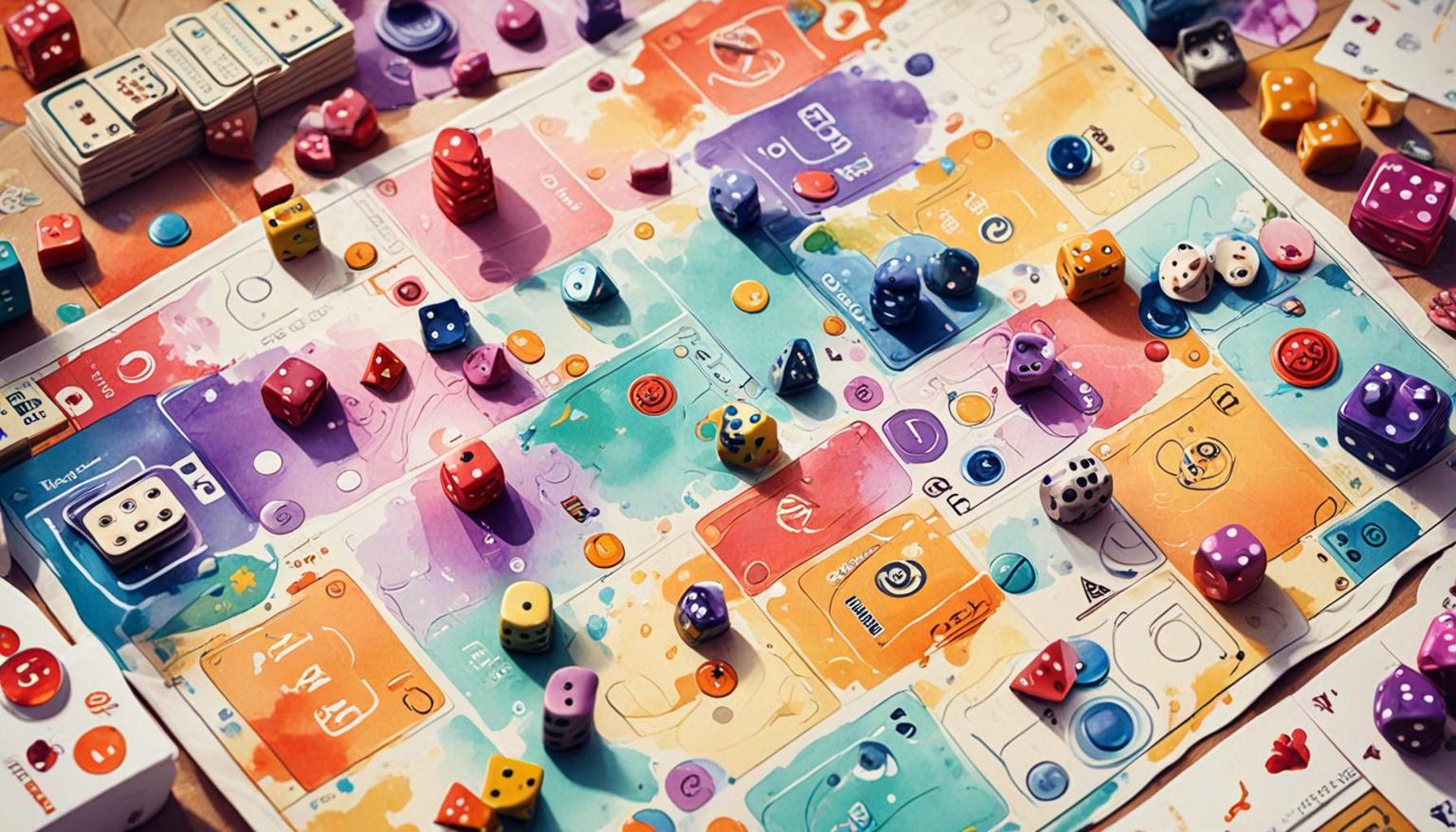The impact of pattern recognition in strategy games and its relation to decision making

Understanding the Role of Strategy in Gaming
In the dynamic landscape of strategy games, players are constantly engaged in a battle of wits, where their success largely depends on their ability to identify and leverage various patterns during gameplay. This skill goes beyond mere observation; it encompasses a deep understanding of game mechanics, economic management, and opponent psychology. A well-honed sense of pattern recognition can significantly enhance a player’s performance and lead to better decision-making outcomes.
One of the key components of decision-making in strategy games is:
- Immediate Responses: Players must develop the capacity to react swiftly to situations as they unfold. For instance, when multiple players congregate around a resource-rich region, recognizing this influx can inform a player to either join the fray or evade to protect their assets, based on previously observed behaviors.
- Long-Term Strategies: Seasoned players leverage established patterns, allowing them to craft sustainable game strategies. This could involve consolidating power bases or developing technologies that are advantageous in the long run, rather than merely reacting to immediate threats.
- Behavior Prediction: Anticipating not just the moves of an opponent but the larger meta-game trends enables gamers to devise effective counter-strategies. For example, if a player frequently uses aggressive tactics, noticing this pattern may lead others to prepare defensive measures or launch unexpected surprise counter-attacks.
The significance of mastering these decision-making elements becomes even more pronounced within the context of Nigeria’s vibrant and burgeoning gaming community. With local eSports tournaments gaining traction, players are increasingly challenged to sharpen their skills in not just gameplay but also strategic thinking. Mastering decision-making through pattern recognition is now more than a personal achievement; it can be a vital component to excelling in a competitive arena.
As we embark on this exploration of pattern recognition in strategy games, we’ll uncover the intricate mechanics that underpin gameplay. From understanding resource distribution to evaluating opponent tactics, this journey promises to reveal how gamers can harness these skills to secure a considerable advantage over peers. Such insights are invaluable not only for players seeking to improve their games but also for those looking to impact Nigeria’s gaming culture positively.
RECOMMENDED: Check out this similar article

The Intersection of Pattern Recognition and Decision-Making
At the heart of competitive play in strategy games lies the intricate weave of pattern recognition and decision-making. Players must hone their observational skills, not merely to react but to anticipate and forge strategies that pave the way for victory. This dynamic interplay is particularly crucial in a gaming environment that challenges players to constantly adapt. The ability to discern patterns can elevate a player’s tactical reasoning, transforming their gameplay from basic movements into a sophisticated chess match.
Crucial Elements of Pattern Recognition in Gameplay
Recognizing patterns influences a player’s decisions, often dictated by the following elements:
- Resource Management: Players must monitor the flow and distribution of resources to optimize their growth. For instance, in a game like Age of Empires, realizing that certain resources are consistently contested can prompt players to either fortify their positions or explore alternative strategies, enhancing their competitive edge.
- Opponent Behavior: Observing the tactics of opponents offers invaluable insights. If a player consistently leverages aggressive approaches, keeping track of these strategies can help others formulate defensive preparations or feints. Such analysis not only allows for immediate adaptations but also for planning future encounters with informed strategies.
- Game Timing: The tempo of a strategy game often dictates success. Players who identify timing patterns—like the optimal moment to strike or defend—are more capable of making strategic decisions that align with the game’s unfolding dynamics. In Dota 2, for instance, recognizing when power spikes occur can allow teams to capitalize effectively on their opponents’ vulnerabilities.
The evolution of the Nigerian gaming scene has provided fertile ground for innovation in pattern recognition and decision-making in strategy games. With a growing number of local players diving into the intricacies of titles such as StarCraft or League of Legends, the emphasis on making split-second decisions while interpreting complex scenarios becomes more pronounced. Many players are now participating in tournaments that challenge not only their skill but also their cognitive abilities—those who master pattern recognition often find themselves at the apex of competition.
This self-enhancing cycle of skill development has broader implications as well; as players cultivate their ability to recognize patterns and make informed decisions, they contribute to the overall caliber of Nigeria’s gaming community. As these players hone their expertise, they foster an environment rich in shared learning, where insights about gameplay intricacies can be exchanged and adapted across the community. This not only elevates the skill level of individual players, but also enhances the collective strategic acumen of Nigerian gamers in the global arena.
With the intersection of pattern recognition and decision-making proving to be pivotal, it becomes clear that understanding these foundations can lead to not only personal growth but also larger advancements within the gaming culture in Nigeria. The journey into these mechanics provides a pathway for players to uncover the secrets of strategic excellence.
| Advantages of Pattern Recognition | Impact on Decision Making |
|---|---|
| Enhanced Tactical Awareness | Players can quickly assess their opponents’ strategies through pattern recognition, allowing them to make informed tactical decisions. |
| Improved Predictability | Identifying potential outcomes based on previous moves fosters confidence and effectiveness in executing strategies. |
The unique skills cultivated through pattern recognition in strategy games lead to profound improvements in decision-making capabilities. As players develop the ability to recognize recurring structures within complex gameplay scenarios, they inherently enhance their problem-solving skills. This is not only limited to gaming; such competencies translate well into real-world applications. For example, professionals in high-pressure environments rely on similar cognitive strategies to navigate their work efficiently. By analyzing past conflicts and outcomes, strategy game players gain insights that assist in predicting opponents’ moves, ultimately shaping their own strategies to assume control of the game. In addition, studies suggest that engaging in these games elevates the brain’s neuroplasticity, which facilitates better adaptation to new strategies and scenarios, thereby reinforcing the importance of recognizing patterns in evolving decision contexts. The more players become adept at these cognitive functions, the sharper their strategic thinking becomes, proving invaluable in both virtual and real-life challenges.
LEARN MORE: This related article may interest you
Implications of Pattern Recognition on Player Performance
The influence of pattern recognition extends beyond immediate decision-making to significantly affect player performance and overall strategy development in games. Players adept at identifying recurring elements within gameplay settings not only enhance their tactical finesse but leverage their cognitive skills to outmaneuver opponents. This advantage manifests in various dimensions, making the comprehension of patterns instrumental for both newcomers and seasoned players alike.
The Role of Cognitive Load Management
One critical aspect of pattern recognition in strategy games is its role in managing cognitive load. As players face intricate challenges, the ability to swiftly identify patterns helps alleviate the mental burden of processing multiple variables simultaneously. For example, engaging in a game like Civilization VI requires players to respond to dynamic changes on the battlefield, manage diplomacy, and optimize resource allocation. By recognizing historical tendencies in opponent behavior or economic trends, players are able to streamline their decision-making processes, making choices based on proven strategies rather than fleeting instincts.
This streamlining can be so impactful that players often develop what is known as emergent strategies. These strategies arise from ongoing practice and are rooted in the recognition of patterns during gameplay. Whether it’s predicting an opponent’s maneuvers in StarCraft or recognizing the significance of army compositions in League of Legends, effective players often rely on established patterns they’ve observed over time, allowing them to develop intuitive combat styles that hinge on nuanced understanding rather than rote memorization.
Training and Skill Development
The growth of the Nigerian gaming community has seen an increasing emphasis on structured training regimens that focus on pattern recognition. E-sports academies and local tournaments have begun fostering a mindset around learning and strategic growth. These platforms encourage players to dissect their gameplay, analyze opponent tendencies, and actively engage in skill assessments. As a result, players are not just battling on a virtual field; they are honing their skills through data analysis and reflective play.
Additionally, participating in forums, coaching sessions, and analysis workshops can further deepen this understanding of pattern recognition. Knowledge sharing amongst players leads to collective intelligence—where advanced strategies are discussed and dissected. In this culture of collaboration, players build a repertoire of responses to commonly observed patterns, which can be particularly advantageous during high-stakes matches.
The Future of Pattern Recognition in Strategy Games
As the landscape of gaming continues to evolve, the role of pattern recognition will only grow in significance. Developers are now integrating sophisticated algorithms that tailor gameplay experiences based on player performance, potentially contributing to more diverse and engaging gaming environments. This evolution also prompts players to continually adapt their recognition capabilities and decision-making processes, ensuring that the dynamics of strategic play remain fluid and unpredictable.
Moreover, with the advent of machine learning and AI perspectives in game design, players may soon find themselves facing challenges that react intelligently to established patterns. This could lead to an ongoing cycle of adaptation, where players strive to stay ahead of game mechanics, thus shaping the future of competitive play.
In essence, the intertwined relationship of pattern recognition and decision-making is reshaping the strategies employed by gamers. This synergy drives players not just to compete, but to innovate and evolve, putting the spotlight on the value of cognitive skills in the rapidly expanding Nigerian gaming scene.
LEARN MORE: This related article may interest you
Conclusion: The Future of Strategy Through Pattern Recognition
The exploration of pattern recognition in strategy games unveils an intricate relationship between cognitive skills and effective decision-making. As players become increasingly attuned to the recurring motifs within gameplay scenarios, they develop a distinctive edge that enhances their overall performance and strategic acumen. This phenomenon is not merely a facet of gameplay; it represents a shift in how players understand competition, emphasizing the significance of adaptable learning over rote memorization.
Within the vibrant context of the Nigerian gaming community, the implications of improved pattern recognition are particularly profound. With various e-sports academies and training initiatives proliferating, players are encouraged to delve deeper into analytical strategies, fostering an environment ripe for innovation and collaboration. As gamers harness collective intelligence, they create a rich tapestry of strategic responses that profoundly impact their performance in high-stakes competitions.
Looking ahead, the integration of sophisticated technologies such as AI and machine learning in gaming design is bound to further revolutionize the dynamics of pattern recognition. As games evolve to respond intelligently to player strategies, the onus is on players to continuously adapt their cognitive frameworks, ensuring that their decision-making processes remain sharp and relevant.
In conclusion, the importance of pattern recognition in strategy games cannot be overstated; it shapes not only the way players engage with their opponents but also fosters a culture of innovation that drives the gaming industry forward. Thus, understanding this connection is crucial for aspiring players and enthusiasts alike, as it provides invaluable insights into mastering the art of strategic gameplay in a rapidly evolving landscape.


